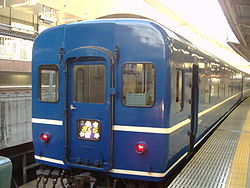.gif)
Sakura (train)
Encyclopedia
The is a high-speed shinkansen
service operated between and Kagoshima
in Japan since 12 March 2011. It was formerly a limited express
sleeper train service operated by JR Kyushu, which ran from to and in Kyūshū
, Japan. The service was discontinued from the start of the revised timetable on 1 March 2005.
 The Sakura was first introduced on 1 April 1951 as a daytime Limited express service between Tokyo and Osaka. This service was discontinued in October 1958.
The Sakura was first introduced on 1 April 1951 as a daytime Limited express service between Tokyo and Osaka. This service was discontinued in October 1958.
The Sakura sleeping car service commenced on 20 July 1959 using 20 series sleeping cars. From March 1972, the train was upgraded with 14 series sleeping cars.
From 4 December 1999, the Sakura ran coupled with the Hayabusa
service between Tokyo and . The last services ran on the evening of 28 February 2005.
From 12 March 2011, the Sakura name was revived once again for the new shinkansen services operating between and using new JR West N700-7000 series and JR Kyushu N700-8000 series 8-car trainsets. Sakura trains operate once every hour between Shin-Osaka and Kagoshima-Chūō throughout the day. There are also additional Sakura services once per hour between and Kagoshima-Chuo during the morning and evening. During the middle of the day there will be two additional runs per hour: One between Hakata and Kagoshima-Chūō, and one between Hakata and . Some Sakura runs within the Kyushu Shinkansen are operated by 6-car 800 series
trains.
between Tokyo and , a JR Kyushu EF81
electric locomotive between Shimonoseki and Moji (through the undersea Kanmon Tunnel
), and by JR Kyushu ED76 electric locomotives from Moji to Nagasaki and Sasebo.
Shinkansen
The , also known as THE BULLET TRAIN, is a network of high-speed railway lines in Japan operated by four Japan Railways Group companies. Starting with the Tōkaidō Shinkansen in 1964, the network has expanded to currently consist of of lines with maximum speeds of , of Mini-shinkansen with a...
service operated between and Kagoshima
Kagoshima-Chuo Station
is the main railway station in Kagoshima, Japan. It is the southern terminus of the Kyūshū Shinkansen and is located on the Kagoshima Main Line, and Ibusuki-Makurazaki Line...
in Japan since 12 March 2011. It was formerly a limited express
Limited express
A limited express is a type of express train service. It refers to an express service that stops at a limited number of stops in comparison to other express services on the same or similar routes.- Japan :...
sleeper train service operated by JR Kyushu, which ran from to and in Kyūshū
Kyushu
is the third largest island of Japan and most southwesterly of its four main islands. Its alternate ancient names include , , and . The historical regional name is referred to Kyushu and its surrounding islands....
, Japan. The service was discontinued from the start of the revised timetable on 1 March 2005.
History

The Sakura sleeping car service commenced on 20 July 1959 using 20 series sleeping cars. From March 1972, the train was upgraded with 14 series sleeping cars.
From 4 December 1999, the Sakura ran coupled with the Hayabusa
Hayabusa (train)
The is a new high-speed Shinkansen service operated by East Japan Railway Company between Tokyo and in Japan since 5 March 2011. The name was formerly used for a limited express sleeping car service operated by JR Kyushu, which ran from Tokyo to , and was discontinued in March 2009.-Service...
service between Tokyo and . The last services ran on the evening of 28 February 2005.
From 12 March 2011, the Sakura name was revived once again for the new shinkansen services operating between and using new JR West N700-7000 series and JR Kyushu N700-8000 series 8-car trainsets. Sakura trains operate once every hour between Shin-Osaka and Kagoshima-Chūō throughout the day. There are also additional Sakura services once per hour between and Kagoshima-Chuo during the morning and evening. During the middle of the day there will be two additional runs per hour: One between Hakata and Kagoshima-Chūō, and one between Hakata and . Some Sakura runs within the Kyushu Shinkansen are operated by 6-car 800 series
800 Series Shinkansen
The is a Japanese Shinkansen high-speed train type operated by JR Kyushu on the Kyushu Shinkansen high-speed rail line. Built by Hitachi, the trains were introduced on the Tsubame services from March 2004....
trains.
Rolling stock
In the 1990s, the train was formed of up to fourteen 14 series sleeping cars, including two cafeteria cars. The train was hauled by a JR West EF66 electric locomotiveJNR Class EF66
The EF66 is a 6-axle electric locomotive designed for fast freight used by Japanese National Railways and currently operated by its descendents JR West and JR Freight.-Background and history:...
between Tokyo and , a JR Kyushu EF81
JNR Class EF81
The EF81 class of electric locomotives are Bo-Bo-Bo wheel arrangement multi-voltage AC/DC electric locomotives operated on passenger and freight services in Japan.-EF81-300:...
electric locomotive between Shimonoseki and Moji (through the undersea Kanmon Tunnel
Kanmon Tunnel
The Kanmon Railway Tunnel, Kanmon Roadway Tunnel, and Shin-Kanmon Tunnel are undersea tunnels crossing the Kanmon Straits between Shimonoseki, Yamaguchi and Kitakyūshū, Fukuoka in western Japan...
), and by JR Kyushu ED76 electric locomotives from Moji to Nagasaki and Sasebo.
See also
- Blue Train (Japan)Blue Train (Japan)' in Japan are long-distance sleeper trains, nicknamed as such for the color of the train cars. They consist of 20-, 14- or 24-series sleeper cars, and currently run on six routes connecting major destinations within Japan across long distances, other routes being served by a fleet of newer...
- MizuhoMizuho (train)The is a limited-stop shinkansen service operated between Shin-Ōsaka and Kagoshima in Japan since 12 March 2011, following the completion of the Kyūshū Shinkansen.-History:...
- the limited-stop service operating on the same route

